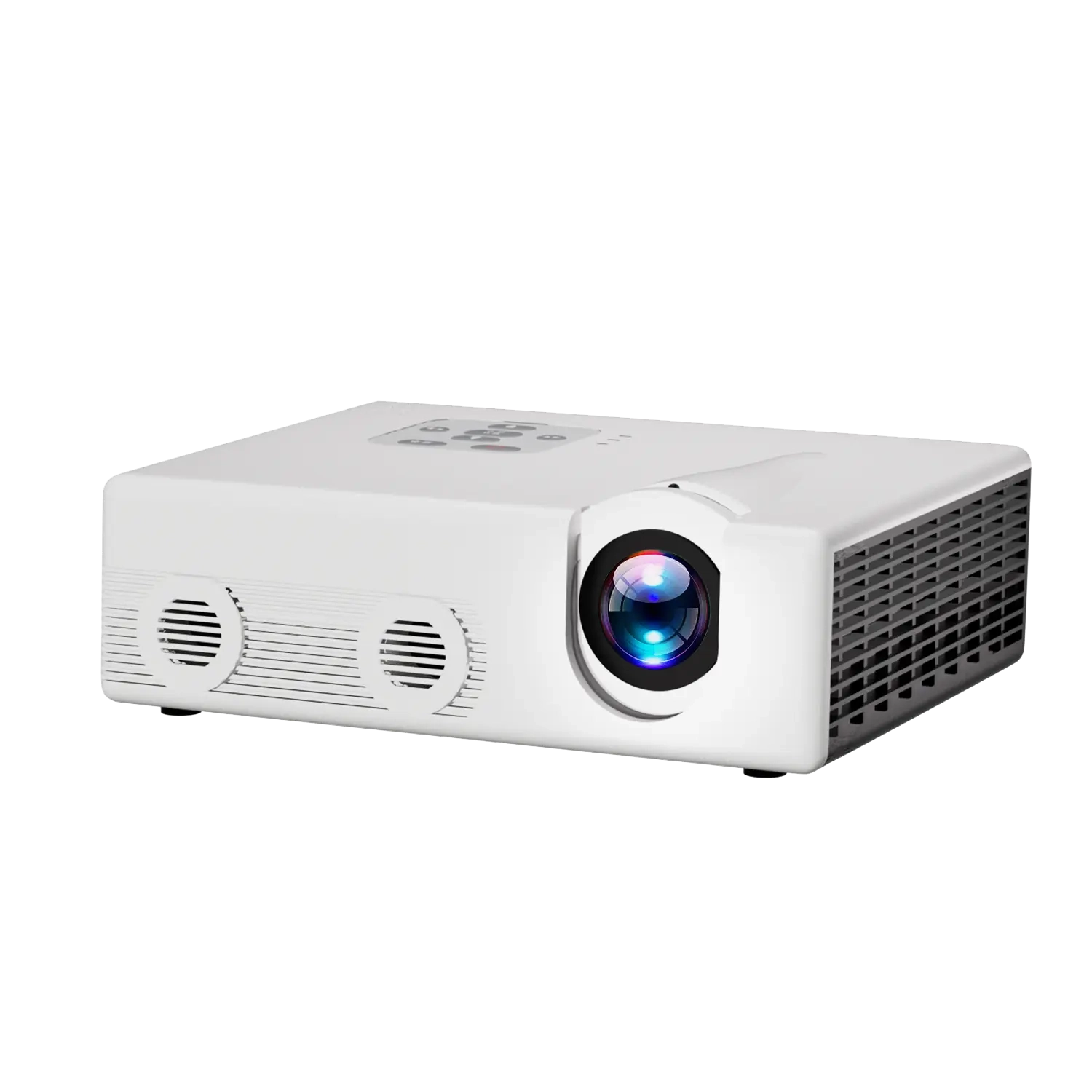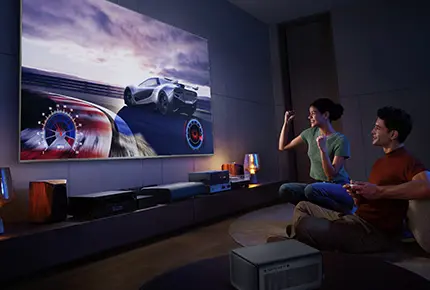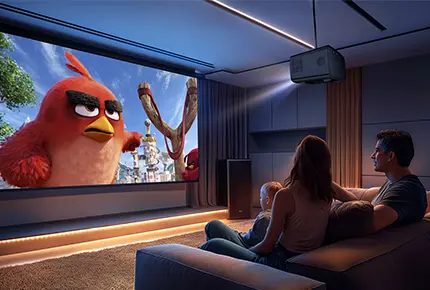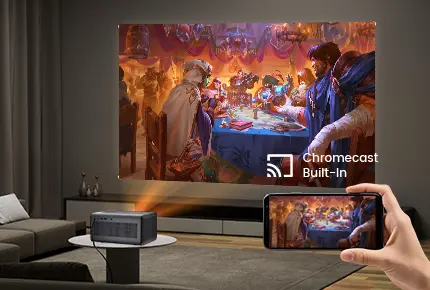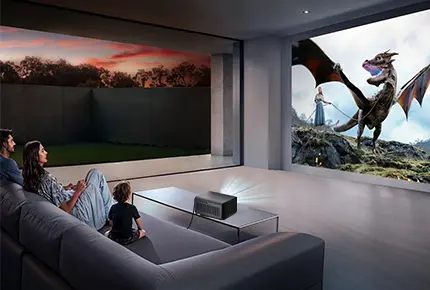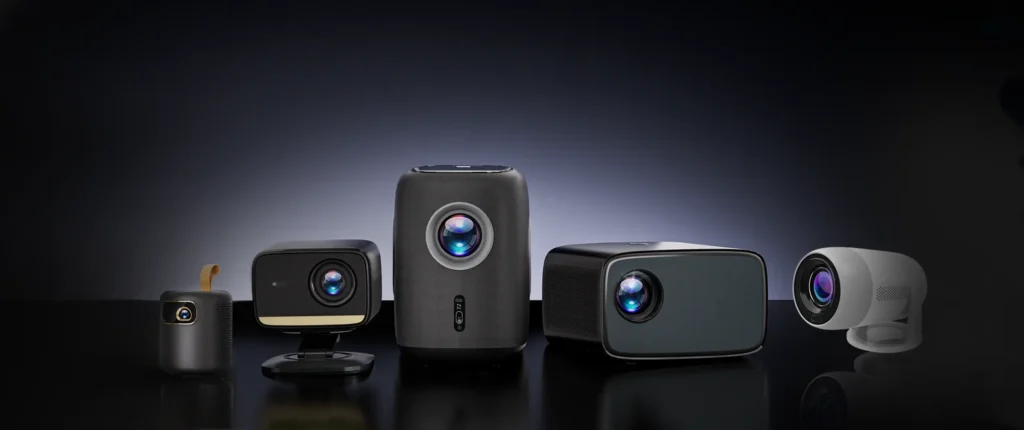
What is the projector
A projector is a device that converts video signals into optical images. The processed optical image is projected onto a screen and then reflected into our eyes, forming the picture we see.
The biggest advantage of a projector is its ability to display large-size images, far beyond the display range of TV screens. In addition, the light from a projector enters the eyes through reflection, which is less stimulating to the eyes compared to the direct light from a TV, providing a more comfortable viewing experience.
How do projectors work
A projector generally consists of three parts: a light source, an imaging system, and a lens.
First, the light source produces strong light that enters the imaging system. The imaging system modulates the light according to the input video signal, converting the light into image information. Finally, the modulated light is magnified and focused by the lens system and projected onto a screen or wall, forming a clear and visible image.
Projector Types
Projectors can be classified from multiple perspectives. Based on the light source, they are mainly divided into lamp projectors, LED projectors, and laser projectors. Based on imaging technology, the common types are LCD projectors and DLP projectors. In addition, according to the focal length of the lens, projectors can be divided into long-throw, standard-throw, and short-throw projectors.
LCD Projector
LCD projectors form images by adjusting the light transmittance through liquid crystal panels. The light from the light source is directed into the LCD panel, which adjusts the light transmission of each pixel according to the input video signal, thus controlling the brightness of each pixel. After light of different colors is modulated by the corresponding LCD units, it is finally combined and projected through the lens onto the screen, presenting a clear and colorful picture. LCD projectors are widely used because of their accurate color reproduction and stable, detailed images.
DLP Projectors
DLP (Digital Light Processing) projectors form images through a chip (DMD) composed of thousands of tiny mirrors. The light from the light source is directed to the DMD, where each mirror corresponds to one pixel in the image and quickly tilts according to the input video signal, controlling the direction of the reflected light and thereby adjusting the brightness of each pixel. After different colors of light are sequentially modulated by the mirror array, they are combined into a color image and projected onto the screen through the lens. DLP projectors feature high contrast, smooth images, a well-sealed structure, and a relatively compact size.
Lamp Projectors
In the past, lamp projectors were the mainstream products in the market, such as those long used in classrooms and conference rooms. However, due to the short lifespan of lamps (usually only 2,000 to 5,000 hours), they need frequent replacement. Maintenance is cumbersome, and lamp prices are high, resulting in a higher overall maintenance cost. In addition, lamp projectors generally have issues such as loud noise, bulky size, and high heat generation. With technological advancements, lamp projectors have gradually been replaced by LED projectors and laser projectors with longer lifespans and better performance, and their market share continues to decline.
LED Projectors
LED is one of the most common light sources for projectors today. Compared with traditional lamps, LEDs have a significant lifespan advantage, usually reaching 20,000 to 30,000 hours, almost eliminating the need for light source replacement and making maintenance very easy. In addition, LED light sources generate low heat, consume less power, and allow for more compact projector designs. However, LED projectors generally have lower brightness, usually between 500 and 3,500 ANSI lumens, making them suitable for environments with low ambient light or smaller rooms.
Laser Projectors
Projectors that use lasers as light sources have significant advantages and are currently one of the mainstream products on the market. Laser projectors generally have higher brightness than lamp projectors and LED projectors, ranging from about 3,000 to 20,000 ANSI lumens. Their lifespan also surpasses that of LED projectors, reaching 20,000 to 30,000 hours or more. Laser light sources have low maintenance costs and deliver clearer images with high color saturation and larger projection sizes. Due to their higher cost, laser projectors are mostly used in high-end home theaters and commercial settings.
Hybrid LED and Laser Light Source Projector
Many projectors on the market now use hybrid light sources, mainly a combination of LED and monochromatic laser light sources. LED + monochromatic laser projectors combine the advantages of higher brightness and color saturation. The laser compensates for the LED’s lack of brightness, while the LED complements the color limitations of a single-color laser and, in a hybrid light source setup, makes overall brightness more uniform and stable, reducing the unevenness often seen with a single light source. At the same time, this hybrid light source inherits the low maintenance cost and high energy efficiency of LED and laser projectors.
Long-throw, Standard-throw, and Short-throw Projectors
The classification of long-throw, standard-throw, and short-throw projectors is mainly determined by the focal length of the projector lens. At the same projection distance, the shorter the focal length, the larger the projected image.
There is also an ultra-short-throw (UST) projector on the market, which uses the principle of light reflection to achieve an extremely short throw, allowing the projector to project a very large image from a position very close to the screen.
In addition, professional commercial installation projectors usually support interchangeable lenses with different focal lengths. Users can choose long-throw, short-throw, or standard-throw lenses according to the installation environment requirements to achieve the best projection performance.
Projector Applications
Projectors are relatively compact and can project much larger images. They are flexible to install and easy to use, so they are widely applied in home entertainment, education, and business. However, different scenarios have different performance and functional requirements for projectors.
Home
For home projectors, rich streaming media and gaming capabilities are very important. Home projectors generally support Android smart systems, which allow them to come with various built-in video apps and download games. They also support wireless screen mirroring from mobile phones, tablets, and computers to share video content with family and friends at any time.
As consumer products, home projectors have relatively low brightness requirements, usually within 3,000 lumens. Entry-level home projectors mostly use LCD + LED solutions to meet daily movie-watching and entertainment needs. High-end home projectors, on the other hand, pursue ultimate image quality and an immersive cinema experience, often adopting laser + DLP or hybrid light source + DLP solutions to create a private home theater environment.
Education
Educational projectors are mainly used in school classrooms or training institutions and are usually ceiling-mounted. To facilitate teaching, these projectors typically feature functions such as automatic power-on when a signal input is detected and automatic sleep mode when no signal is detected for a long time, which helps save energy. Some models also support a 12V trigger function, which can activate an electric screen or electric mount when the projector is turned on. In addition, educational projectors generally have IP5X dustproof capability to cope with chalk dust in classrooms.
Because classrooms are relatively bright, educational projectors need high brightness to ensure clear images, and the larger the classroom, the higher the brightness requirement. Most educational projectors use laser light sources, with brightness usually ranging from 3,000 to 6,000 ANSI lumens, ensuring good projection effects in various classroom sizes.
Office
Office projectors are mainly used for business meetings, presentations, and training. Compared with educational projectors, office projectors focus more on wireless screen mirroring, allowing quick connection and presentation from various devices such as mobile phones, computers, and tablets. In addition, many business projectors have built-in Android systems that support opening documents, playing presentation files, and conducting online meetings without connecting to an external computer.
Because office environments have less dust, these projectors have less strict dustproof designs than educational projectors, but they perform better in convenience and multi-device compatibility.
Exhibitions / Large Venues
Exhibition and large-venue projectors are professional-grade commercial installation projectors commonly used for product launches, immersive environment simulations in museums or science centers, stage visual effects, and large-scale outdoor building projections or light shows.
These installation projectors are powerful, capable of projecting ultra-large images and adapting to complex and changing projection environments. This requires extremely high brightness to ensure clear images even in bright or large spaces. Exhibition projectors typically have a brightness of 6,000 ANSI lumens or more, while large-venue projectors can reach 20,000 ANSI lumens or higher. To maintain consistent effects when multiple projectors display the same image, they must have excellent image uniformity, color stability, and edge-blending support.
In addition, installation projectors generally support interchangeable lenses to meet different projection distances and angles and can achieve 360° installation. In multi-projector setups, they also support signal synchronization and control interfaces for easy debugging and unified management. For outdoor applications, installation projectors need higher dustproof, waterproof, and impact-resistant capabilities to ensure stable operation in harsh environments.
FAQ
How to connect a laptop to a projector ?
Most projectors support both wireless and wired connections to a computer.
Wireless connection: When the computer and projector are connected to the same Wi-Fi network, open the wireless projection application on the projector. Then, in the computer settings, find the “Wireless Display” or “Screen Mirroring” function, select the corresponding projector model, and you can extend or mirror the computer screen to the projector.
Wired connection: Most projectors are equipped with an HDMI port, and some also support VGA or Type-C ports with video transmission. Use the corresponding cable to connect the computer and the projector, then select the corresponding signal source on the projector to extend or mirror the display.
Is a projector better than a TV?
The advantage of projectors is their ability to display much larger images and provide relatively better eye protection. In addition, projectors are compact, easy to carry, and require only a white wall or screen for projection.
In contrast, TVs offer clearer and brighter images, maintaining good viewing effects even in bright ambient light, which projectors cannot easily achieve. The disadvantage of TVs is their larger size, usually fixed placement, and stronger eye stimulation compared to projectors.
Projectors and TVs each have advantages and disadvantages, and the choice should be based on personal needs and usage environments.
How to choose a projector?
First, determine the purpose of the projector to identify the required features. Then, based on the usage environment, evaluate the brightness, resolution, and portability needed. Finally, consider the budget and all factors comprehensively to choose the most suitable model.
If you are unsure how to choose the right projector, feel free to contact us for professional advice.
How do you set up a projector?
First, adjust the distance and angle between the projector and the screen or wall according to the image size and brightness requirements.
Next, perform keystone correction or four-point correction to align the projected image with the screen completely, and adjust the projector focus (most home smart projectors support automatic keystone correction, auto alignment, and autofocus functions).
Then, connect the projector to the device you need for projection (some smart projectors do not require external devices as they come with built-in streaming apps or games).
Finally, set the viewing or gaming mode according to your preference to achieve the best experience.

